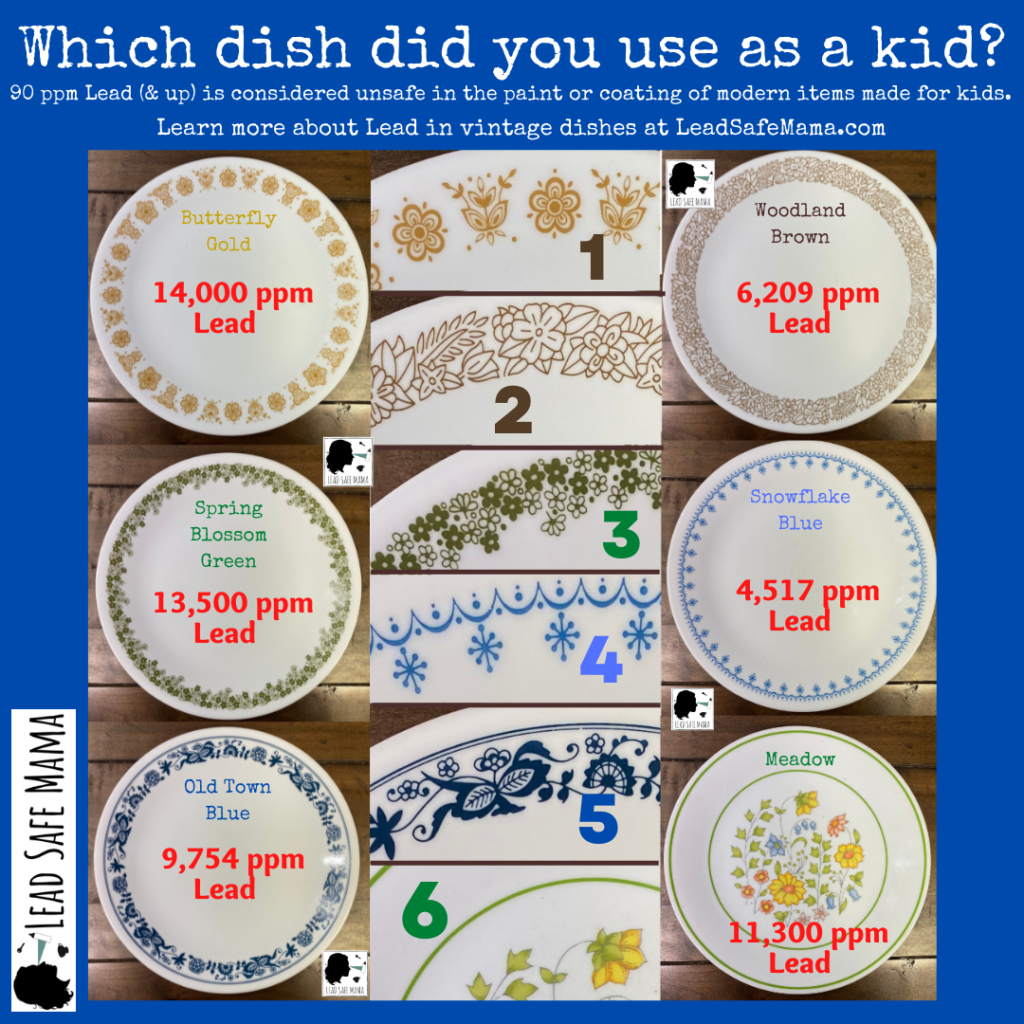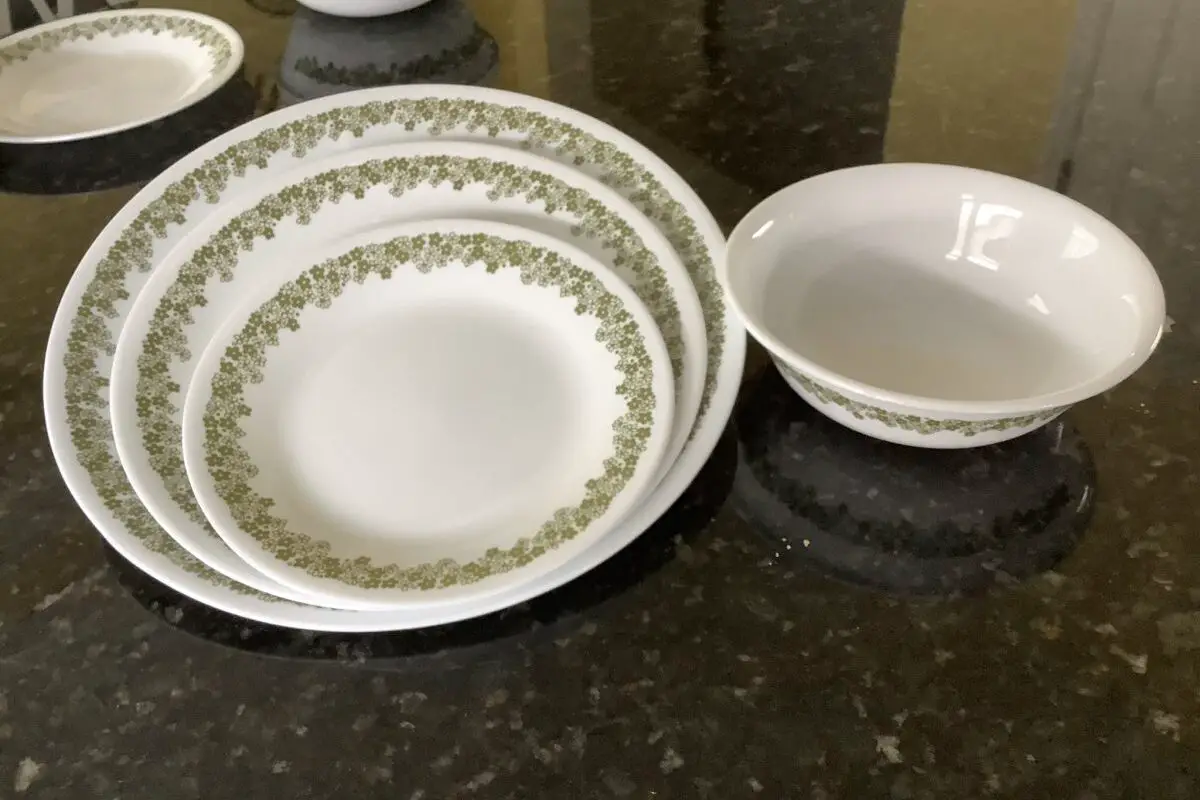We love our vintage Corelle dishes at the cottage. They are the same brand that I had growing up as a kid. They are lightweight, practically indestructible, and easy to clean. Whenever we are in a thrift store, we commonly snatch up an old piece or two that matches our pattern. As a result, we have a nice set that can sit up to twelve guests on those summer days when we have a walleye fish fry on the back porch.
Let’s Cover This Story…
Listen To This Story
What is Wrong With Our Corelle Vintage Dishes?
My wife was looking up something on cookware and ran across this nugget of information on the Internet. A website called Lead Safe Mama (LSM) was testing and presenting lead testing results of vintage cookware. We were floored at what the site was showing—picture after picture of vintage Corelle dishes and cookware we use in our cottage and home. The site indicated the dishes all have high lead levels in the decorative pattern. It turns out that Corning and others were using Lead in the pattern paint up until the mid-2000s. We never received notice that this was present…until now.
Latest Updates on Vintage Corelle Dishes
- Corelle Agrees To Start Testing Pre-2000 Vintage Dishes In Response To New Hampshire Lead Warning
- Outside Lab Vindicates Vintage Corelle Dishes – Determines Dishware Are Approved For Everyday Use
Should You Stop Using These Dishes?
While the independent consumer goods testing work of Lead Safe Mama, LLC is frequently challenged by vintage dishware fans (who are usually quite upset when they first learn that their dishes may not be safe for food use), it turns out that even Corelle recommends that you stop using vintage or older, (pre-2005) decorated Corelle pieces for functional food use purposes.

Lead Safe Mama reached out to Corelle® after they found high lead levels in the painted, colorful decorative elements of many Corelle® pieces. A representative from Corelle® confirmed that the company knew they used Lead in their pieces through the mid-2000s and told the site the company stopped using Lead in their decorative dishware patterns in about 2005.
Corelle Asks Owners to Use The Old Dishes and Cookware For Decoration
In an email exchange reported by a fan of LSM and Corelle®, the company issued the following response about Lead on their older products:
“Before the 1990s, virtually all glass and ceramic ware made anywhere in the world contained Lead as a primary ingredient in the decorating fluxes and glazes. All our products have been Lead-free since the mid-2000s. Lead content has never been regulated until recently. We recommend using the items you have as decorative pieces. We hope this information is helpful.”
It’s More Than Corelle Dishes That Have Lead Paint
Lead Safe Mama has been writing and alerting folks on this topic for over three years. LSM found that Corelle pieces have been high in Lead (and Cadmium) — since shortly after LSM started testing consumer goods for toxicants using XRF technology in 2019.
LSMs site has listed many dishes, bowls, casserole dishes, and Pyrex® measuring pieces that they have tested and reported on. There are too many to list out here. We likely have about 50 pieces between our cottage and home that may be headed to the attic.
Is it Safe to Use New Corelle Dishes?
According to LSM, Corelle® is a worldwide leader in producing lead-free dishware. They promote their basic white items as one of the most reliable Lead-free dishware solutions on the market today.
One of their designs, Bella Faenza, has the detail embossed into the glass (as a texture, not a painted design). These “embossed” Corelle dishes are all lead-free (as long as there are no colored elements.) Lead-free, simple white ones with no ornamental embellishments.
Why Is This Much Lead A Problem?
It just takes a tiny quantity of Lead to poison a child (or any human), and other than Lead Safe Mama, no one is presently examining the potential impact of eating from leaded vintage Corelle dishes.
But Snopes Says This is Unproven
In a six-year-old posting on Snopes.com, an alleged fact-checking site, they contend that the testing and warnings posted by Lead Safe Mama are “Scarelore.” In addition, the site alleges that the lead testing that LSM has paid a third-party accredited testing agency to do on these vintage dishes and cookware is “Unproven.” The Snopes article says the FDA indicated that “the ware is not necessarily unsafe because it is old, but it may not comply with current FDA standards.” They know how to confuse the story.
Consumer Reports Recommends You Should Test Your Vintage Or Imported Dishes For Lead ASAP
Late last year, Consumer Reports Magazine posted an article, Why You Should Test Your Vintage or Imported Dishes for Lead ASAP. The lead content and imported and antique dishes were the emphases of the story. According to Consumer Reports, while imported ceramics are the primary source of worry, consumers should also be aware of the possibility of lead exposure through thrift shop dishware or antique ceramics passed down from generation to generation.
New Hampshire Public Health Services Issues Warning
On May 20th, the New Hampshire Department of Health and Human Services posted a warning on their Facebook Page about older Corelle dishes.
“If you own Corelle® dinnerware from before 2005, consider removing it from your kitchen cabinets due to concerns for high levels of Lead. Corelle® recommends using their pre-2005 dishes as ‘decorative pieces.’
NH Public Health Services
Corelle indicated that it would begin a testing program for its older product lines in response to this warning.
“Given the recent demand for use of vintage products every day, we are further investigating pre-2000 Corelle products to confirm they comply with today’s safety standards – and whether it’s okay to use pre-2000 product as everyday dinnerware.“
Corelle – Instant Brands
Thumbwind will follow the development from the announced Corelle testing and let you know the outcome.
To See All the Vintage Corelle Dishes LSM Tested For Lead
Lead Safe Mama is doing excellent service. The site’s author has worked on this issue for years, and her efforts look to continue. Sadly, we will not be using these old dishes. I’m glad to know this food safety information that no one else seems to have covered.
For more information about the lead found in these and other vintage dishes, click here: Corelle® recommends using their pre-2005 dishes as “decorative pieces” due to concerns for high levels of Lead.
Vintage Dishes and Lead – FAQs
Which Corelle Dishes Have Lead?
Corelle dinnerware sets containing lead are older vintage Corelle plates or Corelle pre-2005 dishes. Decorative patterns are common on vintage Corelle dinnerware. The Corelle Company now encourages consumers to cease using historic Corelle for meals and only use it for decoration.
Which Corelle Dishes Are Safe To Use?
Lead and cadmium can leach into your food from ceramic tableware, especially when it comes into contact with hot and/or acidic food. Furthermore, it is believed that using these plates in microwaves will cause the glaze over the decorative pattern to break down. As a result, possible neurotoxins may leach into food. While this is not 100% proven, the safest practice to prevent lead and other dangerous substances is to use newer, pure white Corelle products.
Can Using Vintage Dishes In Microwave Ovens Cause Lead To Leach Into Food
Yes! In 1996, research was done using pre-1950s US-made ceramic tableware obtained from antique stores and flea markets. They discovered dangerous lead concentrations (>3 microg/ml) in microwave leachates from dishes with uranium-containing glazes, copper-containing glazes, and flowery over-the-glaze decorations. This study implies that using such plates to microwave popular foods might result in unacceptably high levels of lead intake. See – Sheets, R W et al. “Effect of microwave heating on leaching of lead from old ceramic dinnerware.” The Science of the Total Environment
Are Vintage Corelle Dishes the Only Ones With Problems?
No! According to a Smithsonian Magazine article, old Fiestaware, the colorful and most popular collector brand of ceramic dinnerware made from 1936 to 1973, contains uranium and is radioactive.
What are some safe and creative ways to personalize dinnerware, particularly in light of concerns about lead in vintage Corelle dishes?
When concerns arise regarding the lead content in vintage Corelle dishes, basic white items are a reliable choice to ensure the safety of your dinnerware. If you consider personalizing or adding a decorative touch to plain items like bowls, mugs, or teacups, you can explore options like embossing (though it can be challenging to do yourself) or using transfer stickers to achieve a printed effect.
Follow Up Articles
- Corelle Agrees to Start Testing Vintage Dishes and Cookware in Response to New Hampshire Lead Warning
- 18 Articles Covering The Controversial Topic of Lead In Older Corelle Dishes
Related Foodie Reading on Thumbwind

7 Fantastic Michigan Food Companies Not To Overlook
14 Outstanding Breakfast Places Near Me To Check Out In Michigan’s Thumb
5 Reasons You Need To Upgrade Your BBQ To A Pellet Smoker
Ready, Set, Morel! Michigan Morels On Their Way – 5 Hunting Tips





I call bullshit. I’ve had one set for almost forty years and another set for about 20 years. My kids, grandkids, and friends have eaten off of them all this time and nothing has ever happened to anyone.
Good for you. Thanks for stopping by. Read my follow-up article. It gets very interesting.
I’m with you if the corelle dinner ware was that dangerous 2/3 of my generation would be dead…
Lead doesn’t necessarily kill you. It is insidious. https://www.who.int/news-room/fact-sheets/detail/lead-poisoning-and-health
I have pattern number 5. I have had these dishes for at least 30 years or more! I do not believe this article. I love my Corelle dishes!
Read the follow-up article. The New Hampshire Department of Health has issued a warning and Corelle has agreed to further investigate pre-2000 Corelle products to confirm they comply with today’s safety standards – and whether it’s okay to use pre-2000 product as everyday dinnerware.
The bowls that have the decoration on the outside of the bowl, never comes in contact with the food that is eaten. So should be safe, yes?
If after reading this you decide to keep using your dishes no one’s gonna get upset with you but remember knowledge is power..???
I have the ones in the picture. If these are in fact lead based then I think the company should replace them with a set that is kead free.
Good question. However, it’s one I’m unable to answer at this time. We have reached out to Corelle on this point and hope for a reply soon.
I think is defamation, I have used them my entire life and nothing happened.
Defamation is a strong word. To be considered defamatory, the statement must concern a matter of fact, not simply an opinion. In my opinion this question of if the older products (pre-2005) are safe is an open question. A question that Corelle seems to agree since they indicated to the New Hampshire Department of Health that they will be “further investigating pre-2000 Corelle products to confirm they comply with today’s safety standards – and whether it’s okay to use pre-2000 product as everyday dinnerware.” How you chose to use them is your responsibility.
I know people who have dishes like those. Better safe than sorry. I’ll head your advice. Thanks for the info.
Mine are stacked and racked in the Garage pending what Corelle’s testing is. I don’t want to give them up but I don’t want my grand kids exposed to what has long been recognized as a developmental neurotoxicant.
If you feel that our dishes are unsafe. Yes. You should give us a set of yhe same size fir free. Or a vladd action law suit.
I’ve been eating from ours since I believe 1980. At what point is all the lead leached out due to usage and high temperature dishwasher cleanings. At some point hasn’t all the lead either been ingested or cleared out?
How many different patterns
Wow, the fact that people don’t know how lead affects humans leads me to wonder if they have all had their brain cells affected already.
These decorations and MANY others like coffee cups and serving plates were all produced with a post manufacturing process called ACL. That stands for Applied Ceramic Label. The coloring is actually fine colored pieces of ceramic and or paint which, after application, is again fired in an annealing lehr and “baked” into the glass. That is why after years of use it doesn’t come off or deteriorate. There is nothing to fear from Corelle or anything made with this process. if you have older (pre 2005) colored or decorated glasses or coffee mugs and the decoration is fading or deteriorating recycle it
There is a link within the story to Lead Safe Mama. She lists out all the Corelle patterns she has testing.
Will the Corelle / Corning company offer discounts to purchase new sets, for those of us who got them as wedding gifts for everyday use? … More than 35 years ago. I still love that pattern.
I agree ,if they are harmful. They should be replaced by Corell been using them since the 80’s
How do you tell how old the plates are if you bought them over 20 years ago from goodwill I’ve been eating off of them for that long
Hi Joan, We did the same thing. I recommend visiting Lead Safe Mama to see if they have tested your pattern. Regardless, Corelle® recommends using their pre-2005 dishes as “decorative pieces” due to concerns for high levels of Lead.
I think it’s a travesty to just now be seeing this fact. Pre 2000 isn’t that long ago, so they knew and didn’t care. As far as everyone claiming “nothing has happened “, well it very well has on a cellular level. One of the selling features was not worrying about our little kids breaking a plate, they’re lightweight and easy for busy moms to clean! Lead in any form is poisonous and it angers me. However, as of the last few years of learning that about EVERYTHING has been a lie, I give up. I did have some testing done and I showed a fairly high heavy metal range. Wadda ya gonna do? It’s no wonder why my 80-90+ year old seniors are actually more healthy than much younger people; they didn’t grow up being poisoned! Do your best and love all! ???
Thanks for your concern and encouragement.
Lead was removed from paint in the mid 70s due to health concerns that were well known at the time. How could (or why would) a company continue to make dishes into the 21st century with lead based decoration?????